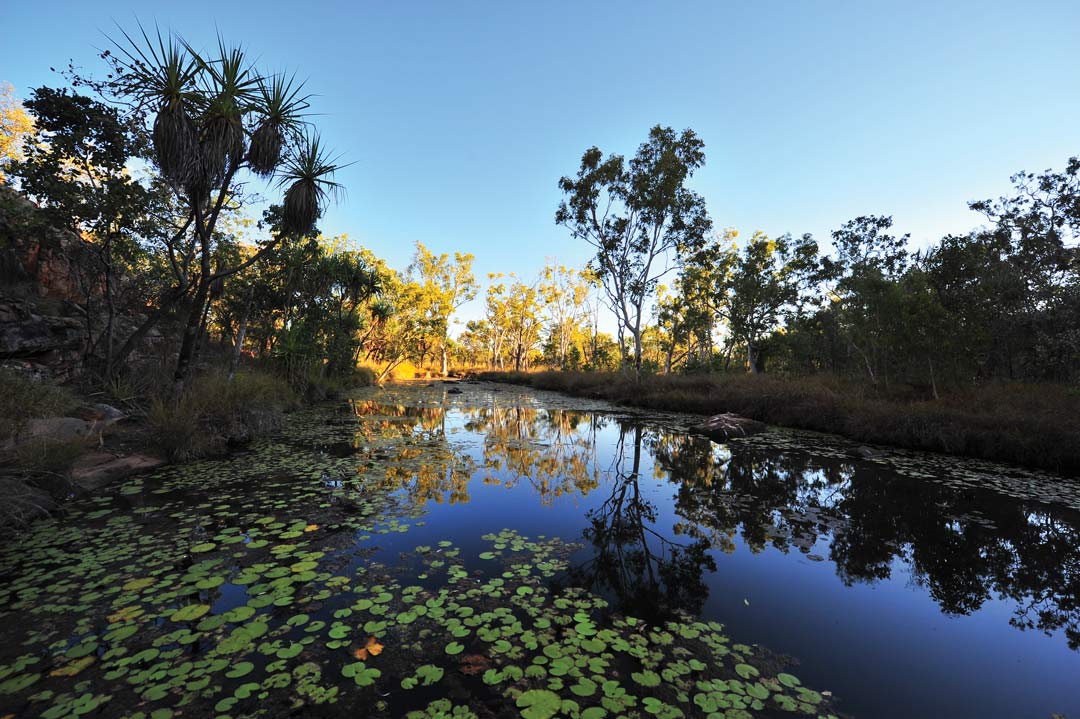:
Kimberley Safety Precautions
 Crocodile Safety
Crocodile Safety
Estuarine or saltwater crocodiles are common residents of Kimberley wetlands. They live mainly in coastal waters and the tidal reaches of rivers, but also occur in freshwater habitats far from the tidal limit. Saltwater crocodiles (or ‘salties’) are most active at night, particularly during their breeding season (September to April).
Freshwater crocodiles are found only in freshwater habitats. They are considered harmless to humans, but will attack if provoked.
However, in the eyes of a large saltie a human is legitimate prey. There have been a number of attacks across northern Australia in recent years, several of them fatal. For the safety of themselves and others who come after, visitors are urged to observe the following common-sense guidelines:
Stingers
Kimberley beaches are at their most inviting from early October to late May, when the weather is hot and muggy. Sadly, this period corresponds to the jellyfish danger period.
Box jellyfish (Chironex fleckeri) are common in coastal waters near mangroves at this time. This is a large jellyfish with a circular body up to 300mm across from which hang as many as 50 venom-charged tentacles up to 3m long. A severe sting causes immediate and incapacitating pain, and the victim may go into cardiopulmonary arrest (i.e. die).
Swimmers may also receive stings from much smaller kinds of jellyfish. These may lead to irukandji syndrome, an unpleasant condition whose symptoms include extreme generalised pain, abdominal cramps, nausea, vomiting and headaches. At first the sting may be just a mild irritation with no identifiable site, and it may take around 30 minutes for symptoms to develop.
The most popular places to swim on the Kimberley coast are the beaches at Broome and the nearby Dampier Peninsula. Box jellyfish and those causing irukandji syndrome are present at all beaches in this area throughout the year. Being transparent, even the largest box jellyfish are all but invisible to swimmers.
The simplest ways to minimise the risk of being stung is to stay out of the water during the main danger period and to wear a protective stinger suit – this particularly applies to small children – at other times. Always seek expert local knowledge before plunging in.
Blood-Sucking Insects
Biting insect pests can be a major nuisance if you haven’t taken steps to reduce their impact. Sand flies (aka midges) are active in coastal areas, particularly at high tide anywhere near mangroves. Mozzies aren’t a problem all year and at all places, but when they’re bad they can be bloody awful. To be on the safe side, presume that they’re going to be friendly wherever you camp – more so if it’s within a kilometre or two of a swamp. Guard against their attempts to ruin your fun by wearing loose-fitting, light-coloured clothing and smearing repellent on exposed skin.
Leeches may occur in wet areas such as swamps and rainforest. Applying repellent to your socks seems to keep them at bay, but if they do get through the defences, simply apply roll-on repellent to their bloated backsides and they’ll fall off. Don’t try to pull them off as the bite may become infected.
Dehydration
The Kimberley is a hot place and dehydration is a real danger. Just how much water you should drink depends on various factors, but an average adult who is mainly just sitting around needs to drink at least 2L of water per day (that’s water, not dehydrating beverages like soft drinks, alcohol and coffee). The quantity required increases with your level of activity until you may need to drink 5L or more if engaged in strenuous bushwalking.
You can use the colour of your urine as a general guide – clear urine indicates that you’re taking in sufficient water, but if it’s dark you need more. Talk to a doctor if in doubt.
Security
Leaving valuables unsecured in your vehicle is asking for trouble. As there’s no telling who is a thief and who is not, it’s unwise to leave attractive items like video cameras and handbags in plain view – it will take only seconds for a practised thief to break in and take the lot. Put personal documents, credit cards, prescription medicine, prescriptions etc into a small backpack and carry it with you at all times. Consider taking out travel insurance.
Camp Robbers
As well as thieves of the human kind, you’ve got to be wary of feathered and four-legged varieties of camp robbers. Clever crows are particularly adept at getting into boxes of tucker and bags of rubbish, and scattering the contents everywhere. Rubbish bins aren’t usually provided in bush situations, and nobody wants to leave food scraps stewing in the hot car while they’re off enjoying nature. However, this is the best place to keep it. Conditions shouldn’t deteriorate too much if you first burn (or wash) opened food containers to get rid of odours. Hungry dingoes (is there another kind?) will sneak into your camp at night and take full advantage of any unsecured food and rubbish. If given half a chance they’ll steal clothing and footwear too.



0 comments